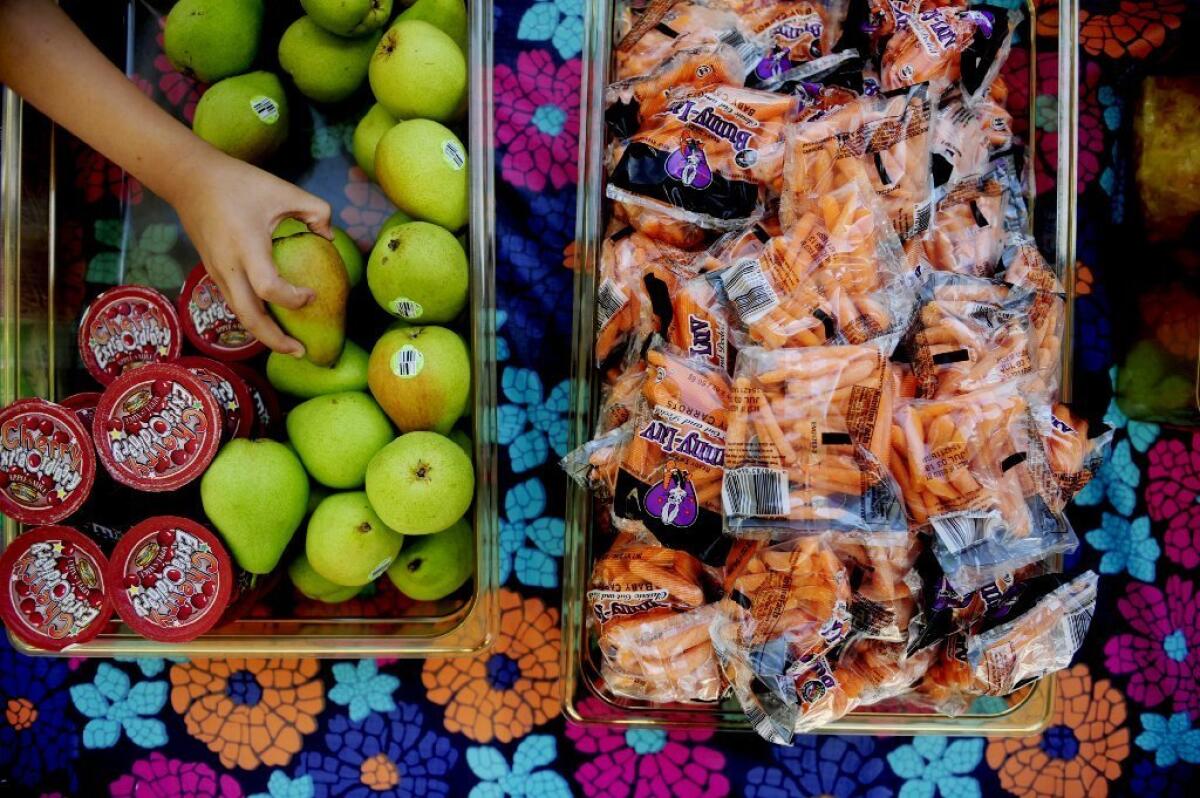Laws against junk food in schools help rich students more than poor ones

- Share via
Since state laws made it harder for California elementary school kids to get their hands on sugary drinks and junk food snacks on campus, researchers found, students’ risk of becoming overweight or obese fell slightly — but mostly if they came from higher-income neighborhoods.
Examining body mass index measurements of 2,700,880 fifth-graders in the state over 10 years, researchers found that students in those neighborhoods saw their odds of exceeding a healthy weight fall by about 1% a year. For all other students, the trends remained essentially flat.
“The magnitude of improvements depended on levels of school neighborhood socioeconomic advantage,” the study authors wrote Monday in the journal JAMA Pediatrics.
The team sought to analyze the effects of two California laws that targeted “competitive food and beverages,” products such as sodas from vending machines and cookies from snack bars that had been sold on campus in addition to school meals.
The first law, which went into effect in 2004, prohibited the sale of sugary drinks and higher-fat milk to students in kindergarten through eighth grade. The second law was implemented in 2007 and set limits on fat and sugar content of snack foods.
To evaluate the laws’ impact, the researchers looked at fitness measurements and body mass index data collected from fifth-graders through California’s Fitnessgram test, which is given to students in the fifth, seventh and ninth grades.
The children were considered overweight or obese if their body mass index was at or greater than the 85th percentile, according to growth charts from the U.S. Centers for Disease Control and Prevention.
The researchers also considered the students’ age and race or ethnicity as well as school size and neighborhood income and education level as measured by the U.S. Census Bureau.
Overall, the proportion of kids who were overweight or obese rose slightly over the course of the study, from 43.5% in 2001 to 45.8% in 2010, the team reported.
But the growth in obesity rate was virtually halted or reversed in the period after the two laws went into effect than it had been in earlier years, suggesting that the policies on competitive foods had a positive, if modest, effect.
“Even small reductions in overweight/obesity can have large impacts for the population as a whole,” said study leader Emma Sanchez-Vaznaugh, a health policy researcher at San Francisco State University.
Other experts said the improvements were encouraging.
“Even though the changes are small, this is one of the few cases where we have actual evidence of improvement linked to a policy change,” said obesity researcher Susan Babey of the UCLA Center for Health Policy Research, who wasn’t involved in the study. “Things aren’t getting bad as fast as they were before.”
The study captured changes only up through 2010. Since then, the federal government has imposed sweeping new rules for school meals, requiring lower levels of sodium, fat and sugar and more fresh fruit, vegetables and whole grains. School food experts say they expect these broader changes to help drive down childhood obesity rates.
In the Los Angeles Unified School District, officials say they have seen a general improvement in student health and fitness since reforming their food policies more than a decade ago. The district banned soda and sugar-based drinks in 2002 and limited sodium and fat in snack foods in vending machines and school stores in 2003. More recently, the district overhauled school lunches to eliminate chicken nuggets and corn dogs in favor of such fare as turkey burgers and vegetarian calzones.
At Beachy Avenue Elementary in Arleta, Principal Stephen Bluestein said the policy changes, along with better health and nutrition education, had made a difference.
“Students definitely know more about what good food is,” he said.
Still, Babey and others said it was alarming that close to half of fifth-graders were overweight or obese and would face an increased likelihood of developing Type 2 diabetes and other chronic health problems.
Elizabeth Velten, state and national policy director for the California Center for Public Health Advocacy, which has pushed for changes in school nutrition standards and menu labeling, said that in order to make a big change in childhood obesity rates, policymakers would need to pay attention to what kids eat outside of school.
Even if it’s harder to get a soda on campus, children in lower-income neighborhoods are disproportionately targeted by food and beverage advertising, said Velten, who wasn’t involved in the study. Their parents also lack nutrition knowledge and face steep prices for healthful fare, she said.
“The healthy choice is rarely the affordable choice,” she said. “As long as a bottle of water costs more than a soda and [food companies] market to lower-income kids, obesity and diabetes rates will go up in those communities.”
Bluestein said his school was among those that had sharply restricted classroom birthday celebrations, phasing out junk food with plans to ban all food next year. He was not surprised that the new study found different degrees of progress in combating obesity depending on the income level of the neighborhood.
At Beachy, where nearly all families are low-income, Bluestein said, vendors wait outside the school to sell such unhealthful snacks as corn slathered in mayonnaise and sugar-drenched snow cones. And for lunch, some parents bring McDonald’s Happy Meals and other foods high in sodium and fat to their children, he said.
At Woodland Hills Elementary, Bluestein’s previous school, in a more affluent neighborhood, the principal said there were no such street vendors and that homemade lunches were generally more healthful — whole wheat sandwiches and salads, for instance.
He speculated that parents in lower-income neighborhoods might not have the time or money to provide better for their children.
UCLA’s Babey said it would take a variety of efforts to reverse the tide of obesity.
“There is no one change that will solve this problem,” she said.
Twitter: @LATerynbrown
Twitter: @TeresaWatanabe








